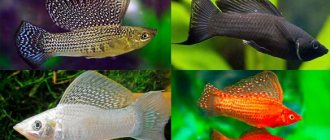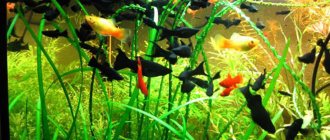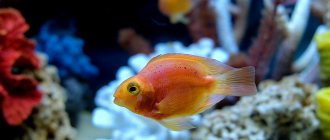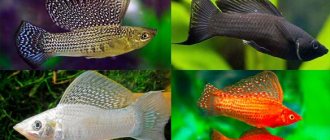Simplicity of content:
Latin name: Poecilia sphenops
Lifespan: 5 years
Maximum size: 10 cm.
Average cost: 150 rub.
Mollies are an excellent choice for an aquarist of any experience. Molly is peaceful, unpretentious, and reproduces easily. Creating optimal conditions that are close to living in the natural environment ensures the health of the fish and the production of offspring.
The bicolor molly is a hybrid of natural species.
Motherland
Mollies are a small viviparous fish belonging to the Petsiliev family. It has a wide distribution range in the wild: southern North America, Central and South America. Inhabits floodplains of rivers in shallow waters, brackish bays and sea coasts. Under natural conditions, the fish feeds on plant food and small crustaceans, which is facilitated by the structure of the oral apparatus. Natural forms of mollies reach 15-20 cm, females of all species are larger than males. Mollies live 7-8 years in the wild, 4-5 in an aquarium.
The main types of molly found in nature:
| View | Latin name | Color | Motherland |
| Mollies sphenops | Poecilia sphenops | Yellow-gray, silver | South America |
| Molliesia latipin | Poecilia latipinna | Silver body with speckles, high dorsal fin | USA, lives in brackish water |
| Molynesia velifera | Poecilia velifera | Silver-green, transparent fins | Mexico |
The coloring of wild fish is rather inconspicuous - there are blue, blue, and green spots on the silver body. The body of the mollies is long, graceful, and muscular. The fish was first described in 1846 by the French zoologist A. Valenciennes, and appeared in aquariums in 1899. Since the 20s of the twentieth century, breeding work began on crossing different species of molly. All modern forms with a short dorsal fin are a hybrid of Sphenops and Velifera, while those with a large dorsal fin are Sphenops, Latipins and Velifera.
Breeding mollies. How to distinguish a female molly from a male
Under natural conditions, mollies usually do not experience difficulties in finding food items to saturate their bodies with nutritional substances. Absolutely any objects suitable in size for a hungry fish can serve as nutritious food. Mollies are happy with any prey, be it a small insect that has fallen on the water surface, a freshwater worm looking for food in the muddy sediments, or an amphipod floundering near the bottom - everything will attract the attention of a hungry fish and arouse in it an ineradicable desire to taste this living creature.
This insatiable creature will definitely not go hungry and will always be able to find a tasty morsel among the thickets of aquatic vegetation.
A characteristic feature of viviparous cyprinodonts, which directly indicates a feeding preference, is the location of the mouth of the aquarium animal. The mouth of mollies has the shape of a narrow slit and is always directed upward - this is a sign of a surface fish that collects food from the upper echelons of natural reservoirs.
In a home aquarium, such specific nutrition can be easily replaced with dry food, a wide range of which is available in any pet store or bird markets in the country.
Female mollies have a more rounded abdomen and a triangular anal fin. While in male mollies the body is more protruding and the anal fin has the shape of a sharp tube, which, during the maturation of the male individual, folds into a thin narrow tube, turning into a gonopodium.
The molly fish is viviparous and therefore, if there is a mature couple in the aquarium, the appearance of fry will not take long.
Male mollies constantly chase females, trying to mate with them. After one-time intercourse, females become pregnant, which lasts 30-45 days and ends with the birth of 20-40 babies. Molly fry are ready to eat immediately after birth.
We suggest you familiarize yourself with: Types of termites and their nests
Mollies are one of the most popular aquarium inhabitants. Such popularity has led to the fact that mollies have undergone serious breeding work aimed at obtaining various color morphs through hybridization.
With that said, there is a lot of confusion on the internet and among new aquarists regarding the identification of mollies that live in their aquariums. Well, we will try to bridge the gaps and help the reader understand the issue of molly species composition.
Molliesia sailing or velifera (Mollinesia velifera)
Types of mollies sailing or velifera
Mollies sphenops (Poecilia sphenops)
Species of molly sphenops
Broad-finned mollies or latipinna
(Poecilia latipinna)
Species of broadfin or latipinna mollies
Mexican molly (Poecilia mexicana)
Species of Mexican mollies
Petena molly (Poecilia petenensis)
Dwarf mollies (Poecilia chica)
There are also several other species - but they are extremely little known.
What kind of mollies swims in your aquarium? We can 99.99% believe that this is not a natural form, but a morph. Mollies now in aquariums are almost exclusively hybrids. Both supposedly “latipinae” and supposedly “velifers” are all selection morphs. All mollies with a small dorsal fin are hybrids of Sphenops and Mexican mollies.
From the horror stories of hybridization, let’s say that all fish are “balloons”, including balloon mollies - this is the selective fixation of a mutation-deformity that arises due to inbreeding (crossing of closely related forms).
Mollies balloon
Just like all Xanthorist breeds, these are aquarium discoloration mutations. Their breeders fix them genetically. Xanthorists are fish that are discolored by developing a yellow tint instead of red or green. Yellow mollies - xanthorista. White, albinos are super xanthorist freaks.
And you say that GLO-fish is wow wow. Here, before Glo, how much wood humanity has chopped up, so mother, don’t worry.
Black mollies
Mollies white
Mollies yellow
Mollies balloon
Red mollies
Mollies Dalmatian/spotted/marbled
Lyre molly or lyretail
This list can be continued ad infinitum, we won’t be surprised if there are gray and raspberry mollies =)
Reproduction of mollies photo male and female
There are no difficulties with the reproduction of mollies. It occurs typically, as in all viviparous fish, and proceeds independently - without special attention from the aquarist. In favorable conditions (absence of nitrogen compounds NH4, NO2, NO3, as well as elevated PO4), the fish give birth regularly.
Males and female mollies can be easily distinguished, and sexual dimorphism is well expressed. In males, the anal fins form gonopodium. Males are thinner, in turn, as female mollies are plump, dense - during the incubation period they are generally “pregnant hippos”.
Given comfortable conditions, mollies produce offspring monthly. When breeding, the male uses a gonopodium, which has a groove for transferring seminal fluid to the female, and a hook, which allows for better grip during fertilization, increasing the chances of pregnancy. Sexual maturity is reached by fish at about a year of age for males, and for females by six months.
Pregnancy lasts approximately one and a half months (35 - 45 days). Signs of pregnancy in a female are a dark spot in the lower abdomen and an enlarged abdomen; such a female begins to seek refuge in the secluded corners of the aquarium. It is advisable to place such a female in a small spawning aquarium with water whose parameters are identical to water from a general aquarium.
Since mollies do not care for their offspring and, moreover, eat their offspring, after spawning the juveniles should be transplanted into a separate tank to avoid “cannibalism.” In this regard, inexpensive seed tanks or separate spawning grounds will be of great help.
However, if there is a sufficient number of shelters in the form of thickets of plants, many fry may well grow to adulthood in a general aquarium. That is, the reproduction and breeding of mollies can, in principle, be carried out in a general aquarium.
It is worth remembering that all morphs of mollies successfully cross with each other, producing hybrid offspring. Therefore, if you want to get beautiful offspring, you should think about quality sires and culling juveniles.
Spawning itself usually occurs in the early morning. Large females can give birth to up to hundreds of fry at the same time, their number depends on the age and size of the female. Molly fry are born quite large; they do not rise from the bottom immediately; at first they lie on the bottom and leaves of plants. Molly fry are very sensitive to water contamination, so in the aquarium where they are kept, more frequent water changes than usual are recommended. In order to increase the immunity of the fry, the water can be slightly salted.
For rapid growth, fry need a varied diet; they are fed with “live dust”, ground with high-quality artificial food or special food for fry. TetraMin Baby is a very powerful food for raising young animals. Please note that the juveniles of any fish are fed frequently (8-10 times a day and around the clock), but in micro portions, just little bits. The point is to always have food available, but enough so that it does not spoil the quality of the water.
Young viviparous fish are very resilient and sometimes survive in extreme conditions, but still, if you have the opportunity, create the most comfortable conditions for the kids and you will soon get many, many grateful mosquitoes who will wag their tails at you when you approach.
As the fry grow, the food for them can be increased in fraction size and volume. Grown-up fry can be given small crustaceans - daphnia, cyclops.
Mollies
Black mollies photo
Mollies desired{amp}amp;nbsp;photo
Mollies desired photo
White mollies{amp}amp;nbsp;photo
White mollies{amp}amp;nbsp;photo
White mollies photo
Males can be easily distinguished from females; sexual dimophysm is well expressed. In males, the anal fins form gonopodium. Given comfortable conditions, mollies produce offspring monthly. When breeding, the male uses a gonopodium, which has a groove for transferring seminal fluid to the female, and a hook, which allows for better grip during fertilization, increasing the chances of pregnancy. Sexual maturity is reached by fish at about a year of age for males, and for females by six months.
Mollies male and female differences
Spawning usually occurs in the early morning. Large females can give birth to up to hundreds of fry at the same time, their number depends on the age and size of the female. Molly fry are born quite large; they do not rise from the bottom immediately; at first they lie on the bottom and leaves of plants. Molly fry are very sensitive to water contamination, so in the aquarium where they are kept, more frequent water changes than usual are recommended. In order to increase the immunity of the fry, the water can be slightly salted.
For rapid growth, fry need a varied diet; they are fed with “live dust”, ground with high-quality artificial food or special food for fry.
Care and maintenance
The fish is quite unpretentious, but for successful keeping and breeding you need to observe the following water parameters in the aquarium:
| Volume per 1 individual | Temperature | Acidity | Rigidity |
| 5 — 10 | 23-28˚C | pH 7.1-7.9 | 22-28 dGH |
Mollies feel more confident when swimming in schools of 7-10 individuals. To relieve intraspecific aggression, there should be 2-3 females per male. The fish spend most of their time in the upper and middle layers of the water; they are quite active. The size of the aquarium must be at least 50 liters, it is better if it is 100 liters or more, rectangular, with a mandatory lid. Mollies sometimes jump out of artificial ponds.
The fish are not picky about the quality of the soil; it can be coarse river sand or medium-fraction pebbles. To prevent the water from becoming cloudy, the soil is thoroughly washed in running water. The bottom is decorated with boiled driftwood or small stones.
An aquarium with mollies must have live plants.
The fish must have secluded corners where it can hide. This can be easily achieved by creating thickets of various aquatic plants in the background. Floating small-leaved plants are needed on the surface of the water. It is better to leave the space near the front window free to give the molly the opportunity to move quickly.
Mollies love hard, slightly brackish water. Experienced hobbyists add 1 tbsp of sea salt to aquarium water. for 20 liters of water. This is possible if the aquarium contains only mollies. Other fish may not tolerate salt water well.
The fish does not tolerate old polluted water with a high concentration of nitrogen compounds: ammonia, nitrites, nitrates. Molly reacts to increased pollution by curling its fins. Filtering is required. It is recommended to replace 25-30% of aquarium water weekly with fresh water that has been left standing for 1-2 days.
The fish needs 12-13 hours of daylight. Illumination should be at least 0.5 W of power per 1 liter of water. Molly does not tolerate sudden temperature changes; a heater must be installed in the aquarium to maintain optimal temperature conditions.
From the many types of compressors, when choosing, rely on the power suitable for your aquarium.
Molly reacts painfully to insufficient oxygen. The installed compressor must match the volume of the aquarium. With a lack of aeration, mollies rise to the surface of the water and begin to greedily swallow air.
Feeding
The fish are unpretentious in their diet and happily eat dried, live and frozen food. Molly's diet should include products of animal and plant origin. With a lack of fiber, mollies eat the soft leaves of plants and destroy green weed filament algae.
Aquarists often feed their fish small portions of chopped lettuce or spinach.
Tetra produces fish food in various packaging, volumes, and filling options.
The Tetra brand produces a line of high-quality balanced dry food for aquarium fish: Tetra Min, Tetra Pro Algae. The food contains the necessary vitamins and microelements. It is harmful for fish to be on a mono-diet. You need to change your diet periodically to avoid addiction. Feeding is carried out 2 times a day. The amount of feed should be eaten within a few minutes to avoid water spoilage.
Mollies are prone to overeating; fish should not be allowed to become obese; this has a bad effect on the health of the gastrointestinal tract and reproductive abilities.
Feeding
Among all viviparous fish, mollies are considered the most capricious and difficult to keep and breed.
The size of the aquarium for keeping them should be significant, with the expectation that a pair of adult fish would have about 6 liters of water or more. In an aquarium, it is desirable to have a long-established biological balance of the environment. It is necessary to provide the aquarium with a large number of open, well-lit areas. You will also need the presence of dense thickets of vegetation, snags, and rock slides for shelters. A significant part of the time, mollies swim in the middle and upper layers of the water of the aquarium.
All mollies are fairly heat-loving fish and prefer water with a temperature of 25–30 degrees. When the temperature of the water decreases or its quality properties deteriorate, and even more so when these unfavorable circumstances combine, they press all the fins to the body and move weakly, sometimes lying on the bottom or swaying in one place.
Fish are demanding when it comes to aquarium lighting - daylight hours should optimally last at least 12 hours. Lighting intensity at the rate of 0.5 - 0.7 W per liter with lamps with an increased red wavelength in the spectrum. It is a good idea to have the aquarium exposed to natural sunlight for 2 hours, but this is not necessary.
Mollies are omnivorous and not picky. They are fed any live, dry or plant food. The diet of the fish must certainly include plant components. Make sure your fish's diet is as varied as possible.
Mollies, photos of which are often featured in publications for aquarists, are viviparous fish. Natural habitat - salty and fresh waters of Latin America, from Colombia to Mexico. Males of mollies are much smaller than females; in nature, representatives of the species reach a length of ten to sixteen centimeters; in an aquarium they are much smaller - they do not exceed eight centimeters.
Mollies, photos of which you can see in this article, were discovered in the southern part of the United States and Central America. They began breeding it in aquariums in 1899, and the first hybrids appeared in the 20s of the 19th century. Under natural conditions, they are yellowish-gray or silver in color and have blue, bluish, green or black spots.
These cute fish are not suitable for crowded small aquariums, although they are quite hardy and will survive even in such conditions, provided regular maintenance and care of their home. When the pH of water drops due to too much organic matter, fish can suffer. A molly aquarium should have regular water changes. A quarter of the total volume changes every 2-3 weeks. If the aquarium is overcrowded, this needs to be done more often.
There is one more feature of keeping mollies in a tank: you need to add two and a half teaspoons of aquarium salt to the water for every ten liters of water. Don’t forget to add salt water when changing. If you add water due to evaporation, then there is no need to add salt, since it remains in the aquarium.
Despite the fact that these fish prefer salt water, they feel great in fresh water, provided that it is not too acidic and soft. Water should be alkaline and hard.
Balloon mollies need live plants in the aquarium. Fish love greens, especially when they add variety to their diet. But try not to overdo it with landscaping—mollies need room to move. Plants floating in the aquarium help the fry survive, and some of them provide additional food. You should not get carried away with picturesque snags - they reduce acidity, and this is undesirable for viviparous fish.
For the substrate, you can use any soil, although on lighter mollies the balloon will better demonstrate its beautiful color. Good filtration is necessary to maintain stable water levels. Additionally, males show their best colors in well-treated water.
These are quite active fish that need a lot of space to swim. If there are few fish, then the minimum volume of the aquarium should be at least 55 liters. If you keep a group of mollies, then it must be increased to at least 75 liters, and the ratio should be as follows: one male to three females. This will help you avoid quarrels between males. Preferred water temperature: 21-28 °C, pH: 7.0-8.5, hardness - 20-30 dGH.
Although experienced aquarists believe that the balloon molly is an omnivorous fish, we must not forget that it has a high need for plant food. The diet of this variety should include plenty of seaweed and other vegetarian foods. In nature, their diet consists mainly of rotifers and algae. Small aquatic insects and crustaceans make up an insignificant part.
In an aquarium, the balloon mollies happily eat ready-made food and live foods, but it especially values large amounts of plant food. Vegetable flakes combined with blanched spinach and fresh cucumbers will be an excellent addition to the main diet. Do not forget to promptly remove the remaining food. Between feedings, mollies will happily snack on aquarium plants and some aquarium algae.
These fish will not refuse protein food either, but they will not be able to exist solely on it. Treat them from time to time with brine shrimp (live or frozen), bloodworms, and tubifex. Meals should be varied, several times a day. Give food in small portions, in such quantity that it is eaten within three minutes.
Fish of the genus Mollies (Poecilia) are native to fresh and brackish waters of Central America. Ballon mollies appeared as a result of human impact on the environment and is not found in the wild, which may be due to the impossibility of adaptation and survival in the natural habitat.
Diseases
Diseases of mollies can be invasive and infectious; non-contagious deterioration in health is often provoked by violations of maintenance rules. When the water temperature drops below 20˚C for a day or more, fish often catch a cold. They lose their appetite and become lethargic.
Gas embolism - occurs with strong aeration or the addition of a large volume of chlorinated tap water. Causes poor circulation, darkening of the gill covers, and bruising. Without taking immediate action, the fish will die.
Invasive diseases are caused by unicellular and multicellular parasites. The fish behaves restlessly and a white coating appears on its body. The sick animal is isolated and Bicillin-5 is added to the water.
Molly breathes heavily, rises to the surface for air when there is a lack of oxygen,
Infectious pathologies:
- Fin rot is a common fungal disease caused by poor quality care and mechanical damage. The fins become deformed, tear, and decrease in size.
- White-skinned - the body turns pale, the eyes turn white, the fins curl up. The pathogen is introduced into the aquarium with plants or new pets. The sick fish is removed and Levomycetin is added to the water.
- Mycobacteriosis - mollies refuse to feed, ulcers and scabs appear on the body, and their eyes bulge. The sick animal is isolated and the aquarium is disinfected.
Fungal pathologies are treated by placing the fish in a saline solution (20 g of salt per 1 liter of water) for 10 minutes.
Recently, aquarium fish have begun to get sick more often, due to the frequent use of antibiotics for fish fry on farms in Southeast Asia, from where goods are supplied to all countries of the world.
Compatibility
Mollies are friendly and get along well with other peaceful inhabitants of the aquarium. Coexists well with fish:
- viviparous - guppies, swordtails, platies;
- labyrinthine - gouramis, laliuses;
- spawning - zebrafish, thorns, rasboras, some types of barbs, angelfish.
When selecting “neighbors” in the aquarium, individuals of approximately the same size are selected. Fish that tolerate hard water well.
Based on the compatibility table, you will find good neighbors for your mollies.
Mollies are poorly compatible with cichlids and predatory catfish species. Mollies often nibble on the delicate fins of goldfish and other veiltails , mistaking them for plants.
Reproduction
Mollies are viviparous fish; fertilization and development of eggs occurs in the womb of the female. During spawning, fully formed fry appear, capable of feeding on their own.
Sexual differences in mollies are visible to the naked eye.
The sexual characteristics of the fish are clearly expressed. The female is larger than the male, has a rounded abdomen and a rounded anal fin. Males are somewhat smaller and have a slender, lean body. The anal fin (gonopodium) is rolled into a tube, used as a gutter for the passage of milk into the female’s body and as a hook for ease of mating.
All morphs successfully cross with each other and produce hybrid offspring, sometimes with unexpected colors. When planning fish breeding, you need to take care of quality producers in order to reduce the number of culling of young fish. Sexual maturity in females occurs at six months, in males at 11-13 months.
The process of courtship and mating can be activated by raising the water temperature by 1-2˚C, partially changing the water, or adding salt. The aquarium should not have high levels of NH3, NO2, NO3, PO4. Producers are intensively fed for two weeks.
Under favorable conditions, mollies are able to reproduce monthly. The female's pregnancy lasts 35-45 days. The ripening of eggs is clearly identified by a dark spot in the lower abdomen and a rounded abdomen. Just before spawning, it is advisable to place the female in a separate aquarium with a volume of 8-10 liters, with thickets of plants in the background.
Female mollies, like all poeciliids, are able to retain the seminal fluid of males in their bodies and fertilize eggs without the participation of a male. After one mating, several pregnancies are possible.
The temperature of the water in the sedimentation tank is raised slightly, but not higher than 28˚C. If the water is too warm, premature birth and stillbirth are possible. Spawning often occurs early in the morning. The fry that are born sink to the bottom, and at first they are inactive. The female, after the end of spawning, needs to be reined in. She is capable of eating her babies. There are 50-100 fry in one litter, depending on the breed and age of the parents.
03:30
Genera of Mollies. Reproduction or spawning of mollies. Lyra mollies.
Fry born in a community aquarium become easy prey for adult fish. In the presence of dense thickets of plants, individual individuals survive.
Raising fry
Babies in the first days of life are fed ciliates or crushed dry food (Tetra Min Baby). The fry are fed 8-10 times a day in small portions. Grown-up kids happily eat cyclops and Artemia nauplii. The water in the aquarium with the fry is partially changed weekly. The young grow unevenly. It is advisable to transplant larger individuals in small batches into a common aquarium to give the small fish the opportunity to fully feed.
Aquarium decoration
In nature, these fish have a yellowish-gray or silver body color with bluish, bluish, black or green spots; the abdomen is usually lighter and without spots. The body is dense, short, the fins are wide and strong.
In this species of fish, females are larger than males. Under natural conditions, females can reach a length of 12–16 cm, and males only 9 cm. In aquariums, mollies grow up to 6–10 cm. It is easy to distinguish a female and a male - the female’s anal fin is rounded, while the male’s is pointed and forms a gonopodium.
Mollies are viviparous fish. Depending on the species, they reach maturity at 5–12 months. Pregnancy lasts 30–40 days. Pregnancy can only be determined by the female's enlarged abdomen. The fry are born fully formed.
Fish do not require any special conditions for breeding. It is enough to plant the female and male together. The female can give birth every 30–45 days. To prevent the fry from being eaten by adults, the female must be placed in a separate aquarium in advance.
The fry eat food for adult fish, ground into powder. The fry grow well and quickly, but to speed up their growth, you can feed them chopped tubifex.
Mollies are one of the most beautiful fish. Keeping most species is simple and accessible to beginner aquarists. Velifera mollies and balloon mollies are more difficult to breed and require careful care and constant supervision. These species are more suitable for experienced aquarists.
But all the worries and troubles are compensated by the beautiful fairy-tale fish flashing among the green algae.
We suggest you read: How to give a cat a massage for constipation. How to properly massage the hind legs of a cat. Why does a cat need to massage his back paws?
How is the sex of fish determined:
- Females are larger than males and have a round belly and a triangle-shaped anal fin. Females become sexually mature at 5–6 months.
- The anal fin of males (gonopodium) is tube-shaped. In males, the period of sexual maturity occurs at the age of 8–12 months.
- Mollies change sex if living conditions require. This function is inherent in all viviparous fish species and is needed to preserve the population in an emergency.
When the breeding fish have passed puberty, start breeding them; if you want to sell future fish, then you should approach this responsibly and be prepared. It is important to know how mollies give birth.
Look at the birth of the molly fish.
It is better to reproduce in an aquarium specially prepared for this purpose, in which the appropriate temperature regime will be set, comfortable for the life of the fish, as well as a lot of vegetation. Important! The water temperature should not exceed 28 degrees, otherwise the mollies fry will be premature, and in this case it will be extremely difficult for them to emerge.
After preparing the aquarium for breeding mollies, select a male and female that have completed puberty. The male, with the help of the gonopodium, fertilizes the female, while the mollies may not be pregnant the first time. It may take up to 10 fertilization attempts. But, if everything is done correctly, then under such comfortable conditions the offspring will be born within a month.
When the abdomen becomes round, you can be sure that she has become pregnant and you should expect the birth of fry soon.
A pregnant molly walks for 8–10 weeks and gives birth to from 30 to 200 fry (large individuals). Before giving birth, the male is removed from the aquarium, but the molly continues to give birth anyway, because it retains the fertilized eggs. Mollies give birth every one and a half to two months, and without the further participation of the male, they produce offspring for another six months.
Under excellent housing conditions, the offspring will be numerous and healthy. If you want the breeding of mollies to belong exclusively to one species, then you should carefully ensure that the species do not interbreed. Keep only one species in the aquarium or move a couple of individuals to another place for spawning.
How to raise molly fry in the first days of life? The fry that are born are almost invisible, they are transparent and blend in with the water, but there is nothing to be afraid of, there is no need to care for the fry, they do it on their own, but it is still worth keeping an eye on the mollies fry. Mollies spawn large from birth, they are able to feed themselves, so they do not need parental care.
It is better to place the female with adults; mollies usually do not touch their offspring, but there are cases when parents attack the fry. Children need to specially prepare an aquarium with a volume of 40 liters or more. The fry sense changes in water very subtly, the temperature should never be exceeded or lowered, it should be exactly 26 degrees to prevent contamination, the water should be filtered daily and changed once a week.
Look at the fry in the plate.
Diseases of fry
Living things are susceptible to diseases, and fish are no exception to the rule. It is important to know how to care during this period.
Common causes of the disease:
- Excess oxygen in the water, the fish becomes restless, its gills darken. The disease is called gas embolism. To eliminate the symptoms, change the water to something suitable for fish based on the amount of oxygen in it.
- Improper conditions of detention. This reason leads to the occurrence of incurable tumors in fish; it is impossible to help them with such a disease.
- Too cold water causes the fish to catch a cold, they lose energy, swim on the surface of the water, and lose interest in food. The solution is simple - create the correct water temperature.
This variety also has a shortened body, with a noticeable curvature of the ridge. The balloon mollies fish does not grow more than six centimeters. Its peculiarity is its large abdomen. It is the result of modification of the species. Internal organs are compressed and small. The body color is somewhat reminiscent of the mollies latipin. But today individuals of other shades are widespread: orange, red, black, silver, gray.
These fish greatly decorate the aquarium, so for many hobbyists it is important that a balloon mollies live in their underwater kingdom. How to distinguish a female from a male? It’s quite simple - males have a cone-shaped genopodia (anal fin), while females have a rounded one.
Mollies are viviparous fish: the offspring are born fully adapted to life in water. The lifespan of this variety is from 3 to 5 years.
Mollies easily reproduce in an aquarium, and the offspring reach sexual maturity very quickly. Depending on the size of the fish and age, the female gives birth to up to one hundred fry. In addition, the peculiarity of viviparous fish is that the male’s sperm is stored in the female’s body for a long time. This allows fry to be born several times, even if the male is removed from the aquarium.
For breeding, you only need to purchase individuals of both sexes, and these fish will overpopulate the aquarium in a short time.
Mollies are active, but at the same time peaceful inhabitants of the aquarium; they are very sociable and love to live in the vicinity of their own species or with other viviparous fish. Males sometimes quarrel, but do not cause each other serious injuries. Only some fish exhibit a character that can manifest itself in aggressive behavior. Mollies can be kept with any fish that has a similar temperament and has the same requirements for the chemical composition of the water.
Avoid proximity to fish that can damage the fins of their peaceful neighbors. This primarily applies to the Sumatran barb. Bottom-dwelling catfish, corydoras, platies, other viviparous fish, and some species of rainbow fish will become their best neighbors. Tetras, cyprinids, and other characins, which are able to live in such water parameters, coexist well with mollies.
Breeding mollies at home does not cause any trouble for the aquarist if he follows simple rules. First you need to prepare a separate aquarium, in which there will be a lot of vegetation and the water temperature is maintained at the level necessary for the fish.
We invite you to read: Apiary for beginners - building a hive from scratch
Anal fin - a sharp difference between the male
Determination of gender
It is quite easy to distinguish between male and female mollies based on some features. Females are larger than males and have a triangle-shaped anal fin. The fish becomes sexually mature and ready to mate within 5 months after birth.
A distinctive feature of males is the anal fin - it has the shape of a tube. It will be ready for mating 8 months after birth.
It is important to maintain the water temperature no lower or higher than 28 degrees. Otherwise, the fry will be born ahead of schedule, and saving them will be quite difficult. Spawning of mollies can also occur in a general aquarium, but it is important to maintain the temperature regime and provide a sufficient amount of free space.
After the aquarium is prepared, you need to select a male and female that have completed puberty. They will begin to mate only if they like each other, otherwise they will have to choose other partners. Fertilization may not occur the first time, so the couple should be left in the same house for several days. But with a successful combination of circumstances, fertilization will occur the first time, and the offspring will appear within a month.
It is better to remove the male before giving birth
When a female's abdomen becomes round, we can safely say that she is expecting offspring. The pregnancy process lasts up to 10 weeks. At a time, a female is capable of giving birth to from 30 to 200 fry, but the latter option is applicable only to large individuals.
Before giving birth, the male must be removed from the aquarium, but this will not affect the birth of the babies. The female is able to retain fertilized cells for quite a long time. Childbirth occurs every two or three months and continues throughout the year. The participation of the male in this process is not required.
Caring for fry
Popular types
All modern species and breeds of mollies are morphs obtained as a result of crossing natural species. The sizes of fish living in aquariums are smaller than those living in natural reservoirs. The life expectancy of hybrid forms is shorter, 2-3 years.
The most common types:
Black mollies (molly lyra)
The most common type has a black velvety color, often with a metallic olive tint. The fish is unpretentious and is recommended for breeding for beginners. Lyra mollies are distinguished by their elongated tail, curved on both sides.
Mollies orange
Sphenopsis hybrid, yellowish-golden fish, body length 6-7 cm. It is unpretentious. There are two-color orange and black forms.
Silver spotted molly (Dalmatian)
There are speckled black spots scattered against the light background of the body color. The size of the fish is 6 cm.
Silver mollies (Snowflake)
The body of the fish is white with a blue tint, 8-10 cm long. Unpretentious, easy-going.
Mollies balloon
A breeding form of the broadfin molly, a fixed genetic mutation. The body of the fish with a curved spine and convex abdomen resembles a barrel. Fish are susceptible to disease and rarely live more than 2 years.
Sail molly
The fish is silver-green in color, 8-12 cm in size. The fins are transparent with a pearlescent tint. The size of the dorsal fin can be equal to the length of the body.
Red leopard
The breed is not very common. The color is original: the body is bright orange, the tail is lyre-shaped and black-speckled.
The average price of fish in pet stores is 120 rubles. The cost of Molly Red Leopard is slightly more expensive - up to 200 rubles.
Mollies are a fish that certainly deserves attention. The variety of colors, peacefulness, ease of maintenance and care make it invariably popular among aquarists.
Peculiarities of breeding mollies in captivity
Breeding mollies at home becomes possible when females reach the age of 6 months. In males, sexual maturity occurs after the first year of life.
It is difficult to distinguish a male from a female at first glance. The main characteristic of a female is a more rounded body. Sex can also be determined by the anal fin. In males it has a pointed shape, in females it is slightly rounded. Often male fish are smaller in size compared to females.
The main distinguishing feature of the male is the anal fin - gonopodium.
The start of mollies spawning is stimulated by an increase in water temperature. If it does not reach 26-28 degrees, reproduction will be delayed. On the eve of spawning, the male and female should be provided with live food rich in protein. It is recommended to supplement their diet with flakes, frozen bloodworms, brine shrimp and live worms. Feeding should be portioned, which means taking food in small portions several times during the day.
To reproduce in an aquarium, mollies will need a large spawning tank with a volume of 80 to 120 liters. Several couples live in it. Most often, groups of fish are formed by three females per one male. It is important to maintain this balance, otherwise the female mollies may begin to chase the male.
If aggressive individuals appear, you will need to remove them from the aquarium.
Gupeshki can be considered ideal neighbors for molly, especially during the breeding season.
To fertilize, the fish come into close contact. Conception occurs with the help of the gonopodium, a special organ in the male designed to excrete seminal fluid and transfer it to the female. As a rule, pregnancy does not occur after the first mating. Often up to 10 copulations may be required.
The male becomes sexually mature at approximately 10 - 12 months, the female at 6. The pair should not be placed in the spawning aquarium, otherwise the larger female will attack the male. When selecting 3 females, competition is created.
Mollies are capable of breeding in both salt and fresh water. Under optimal conditions, spawning occurs a month or two after settling in the spawning area.
The male reproductive organ is cone-shaped and is called the genopodia. Through it, the seed is transferred, and the male also holds onto the female during the sexual process, thereby increasing the likelihood of fertilization. Given how mollies reproduce, the female does not always become pregnant on the first try. It happens that it is possible to successfully copulate only the 10th time.
After the first birth, you can pick up the male from the spawning area. The female retains fertilized eggs. The fish does not give birth once, but gradually. After each birth, a certain number of embryos remain in the mother. The formation of offspring from egg to fish continues for 40–50 days after the first birth.
The species is characterized by the ability to change sex with changes in living conditions. Females can become males if the population needs to recover.
Spawning of mollies can take place only at 5–6 months in females, and at 8–12 months in males, since it is at this age that the fish begin puberty. To avoid hassles, aquarists choose not a couple of molly fish for breeding, but four individuals: one male and three females. After a pregnant molly gives birth, fertilized eggs remain in its body, and even if the breeding male is removed from the aquarium, the females can still reproduce.
Reviews
We bought a black molly, read in the literature that it needed company, and purchased 5 more pieces. The fish look beautiful against the background of greenery and have a peaceful character. I consider the disadvantage of keeping it to be that the water needs to be kept perfectly clean. Elena 35 years old, Moscow region.
I've been breeding molly for several years. I have black lyres and colorful balloons. Recently, while I was away, the water in the aquarium dropped to a low temperature. The fish became ill and a fungal coating appeared on the body. I had to put him in a saline solution for treatment. Nothing, we got better. Mikhail 40 years old, Tula
Mollies are one of my favorite fish. She gets along well with other inhabitants. Refers to livebearers , I like young people to grow up in the aquarium. I have several breeds of molly, it’s interesting to see what color the offspring get. Ekaterina 48 years old, Vologda











